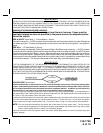
128-7762
5 of 19
This Remote Start System is designed for use with Automatic Transmission Vehicles Only! The unit provides
wait to start input for glow plug pre-heat which will be used for all diesel applications. If this wire is not
connected, then the unit will remain in the Gasoline mode setting, which will crank the car when the RF signal is
received with no delay. Regardless of the vehicle, Gasoline or Diesel, for every installation, the vehicle MUST
HAVE a Tach Signal Input, and an Automatic Transmission.
INSTALLATION OF THE MAJOR COMPONENTS:
CONTROL MODULE:
Select a mounting location inside the passenger compartment (up behind the dashboard). The mounting location
selected must be within 24" of the ignition switch wiring harness to allow connection of the 6 pin main wiring
harness.
Be certain that the chosen location will not interfere with proper operation of the vehicle. Avoid mounting the
module to or routing the wiring around the steering shaft/column, as the module or wiring may wrap around or
block the steering wheel preventing proper control of the vehicle. Secure the module in the chosen location using
cable ties or screws as necessary.
NOTE: Do Not Mount The Module In The Engine Compartment, as it is not waterproof.
HOOD PIN SWITCH:
The hood pin switch included in this package is required for the safety shut down of the remote start unit. If the
vehicle is being worked on, this hood switch prevents the remote start activation even if the RF command to start
is issued. This hood pin switch MUST be installed in all applications. Failure to install the hood pin switch may
result in personal injury or property damage. Mount the hood pin switch in an area under the hood that is away from
water drain paths. If necessary, the included brackets may be used to move the hood pin switch away from rain
gutters or allow mounting to the firewall behind the hood seal. In either case the hood pin switch must be set up
to allow the hood to depress the switch at least 1/4" when the hood is closed and fully extended when the hood is
opened. For direct mounting, a 1/4" hole must be drilled. Carefully check behind the chosen location to insure the
drill will not penetrate any existing factory wiring or fluid lines. Drill a 1/4" hole in the desired location and thread the
hood pin switch into it using a 7/16" nut driver or deep well socket. If using the mounting bracket, first secure the
bracket to the desired location and secure the hood pin switch in the pre-threaded mounting bracket hole.
PUSH-BUTTON LED SWITCH
Select a mounting location known and accessible to the operator of the vehicle. A dash knockout plug or front dash
panel is desirable as the now Push-Button LED assembly needs the LED to be visible from the outside of the
vehicle and will be used for valet modes, programming features, programming transmitters, and for overriding the
remote start unit when the vehicle is being serviced. Inspect behind the chosen location to insure that adequate
clearance is allowed for the body of the switch, and also that the drill will not penetrate any existing factory wiring or
fluid lines. Drill a 5/16" or 8mm hole in the desired location and mount the switch by passing the connectors, one
at a time, through the panel from the front side and pressing on the bezel until the switch is fully seated.
This system is to be used in vehicles with AUTOMATIC TRANSMISSIONS only! Although this combination Keyless
Entry/Remote Start unit is a sophisticated system with many advanced features, IT MUST NOT be installed into a
vehicle with a manually operated transmission. Doing so may result in serious personal injury and property damage.
THE RECEIVER/ANTENNA ASSEMBLY:
The Superheterodyne Receiver Antenna Assembly provided with this unit allows routing from below the dashboard
for maximum operating range. Choose a location above the belt line (dashboard) of the vehicle for best reception.
Special considerations must be made for windshield glass as some newer vehicles utilize a metallic shielded
window glass that will inhibit or restrict RF reception. In these vehicles, route the antenna toward a rear window
location for best reception. Secure the antenna with double stick tape provided. After securing the antenna with
tape, we advise also securing a section of the antenna cable to a fixed support. This will prevent the antenna from
dropping down in case the double stick tape is exposed to extreme heat, which may loosen its gummed surface.
Route the 3 pin connector toward the control module using caution not to pinch the cable as this will cause poor or
no RF reception to the control module.


















